Research on Solar Collector
A special issue of Energies (ISSN 1996-1073). This special issue belongs to the section "A2: Solar Energy and Photovoltaic Systems".
Deadline for manuscript submissions: closed (29 February 2020) | Viewed by 35246
Special Issue Editor
Interests: solar energy; solar thermal energy; csp; parabolic trough
Special Issues, Collections and Topics in MDPI journals
Special Issue Information
Dear colleagues,
In the last decade, large-scale deployment in the commercial use of tracking solar collectors has occurred thanks to new large solar power plants using parabolic troughs or solar tower plants. This fact has piqued the interest of the research community and of industry in new optical designs of solar collectors, but also in investigating the performance, limitations, and operational and maintenance issues of current solar collector designs, including specific research on receivers, optical concentrators, tracking systems, etc. It has been also found that in some cases there is a lack of standard test procedures to perform a complete characterization of specific designs of solar collectors, especially for those developed for high solar-energy concentrations (line-focus or point-focus solar collectors of large aperture).
This Special Issue is intended to invite recent research on solar collectors for medium temperature applications, both line-focus and point-focus, conceived for industrial process heat or combined thermal and electrical applications (e.g., concentrated photovoltaic thermal CPV/T solar collectors), and high temperature applications, independently if the final application is the coupling of the solar system to a power block for electricity production or the supply of high-temperature thermal energy to any industrial application.
Research on parabolic troughs, linear Fresnel collectors, parabolic dishes, heliostats, and/or any other innovative tracking solar collector design is welcome to this Special Issue, whose main emphasis is on articles related to solar collectors’ development, testing, and/or performance and not to specific applications of the technology.
Dr. Loreto Valenzuela
Guest Editor
Manuscript Submission Information
Manuscripts should be submitted online at www.mdpi.com by registering and logging in to this website. Once you are registered, click here to go to the submission form. Manuscripts can be submitted until the deadline. All submissions that pass pre-check are peer-reviewed. Accepted papers will be published continuously in the journal (as soon as accepted) and will be listed together on the special issue website. Research articles, review articles as well as short communications are invited. For planned papers, a title and short abstract (about 100 words) can be sent to the Editorial Office for announcement on this website.
Submitted manuscripts should not have been published previously, nor be under consideration for publication elsewhere (except conference proceedings papers). All manuscripts are thoroughly refereed through a single-blind peer-review process. A guide for authors and other relevant information for submission of manuscripts is available on the Instructions for Authors page. Energies is an international peer-reviewed open access semimonthly journal published by MDPI.
Please visit the Instructions for Authors page before submitting a manuscript. The Article Processing Charge (APC) for publication in this open access journal is 2600 CHF (Swiss Francs). Submitted papers should be well formatted and use good English. Authors may use MDPI's English editing service prior to publication or during author revisions.
Keywords
- concentrated solar-energy
- tracking solar collector
- parabolic trough
- CPVT
- linear Fresnel
- parabolic dish
- heliostat






